With students’ increasing reliance on digital platforms for information and decision-making, it is no surprise that search engine optimization (SEO) has become one of the most critical aspects of education marketing today. But you might wonder, “What is SEO in education?” SEO in education refers to optimizing educational websites by using relevant keywords and creating quality content to improve their visibility in search engine results. SEO not only ensures that schools rank high in search results, but it also enhances their overall online presence and accessibility. This visibility is crucial for attracting new students, as it might improve the perceived value of the institution in the eyes of prospective students and parents.
As the digital landscape continually shifts, educational institutions must adapt and evolve their strategies. From high-authority backlinks to social media SEO and topic clusters, the changes we saw in SEO in 2024 will continue to expand and evolve in 2025. Continue reading about six key higher education SEO strategies you must remember this year as you improve your online presence.
What is an SEO strategy for education?
An SEO strategy for education involves a series of actions designed to improve the visibility and ranking of their website in search engine results pages (SERPs). An effective SEO strategy is often multifaceted, incorporating several targeted approaches to maximize online visibility to attract more prospective students and parents.
Example: Whenever HEM starts working with a school, we first develop a strategy. We look at the factors that the school should consider and design an action plan based on that.
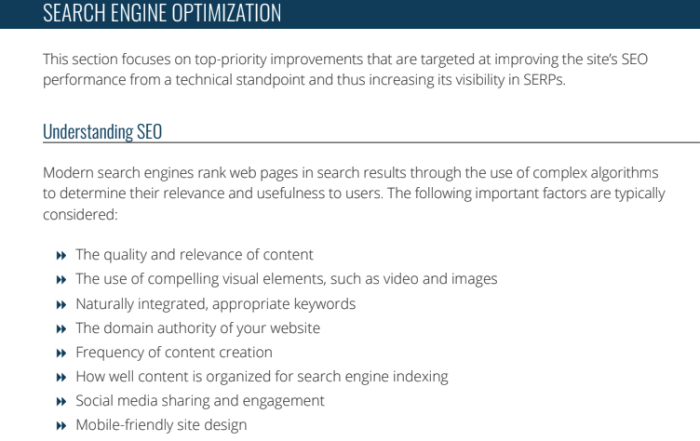
HEM can improve your school’s SEO so you can generate more student inquiries from the world’s most popular search engines! Get in touch with us today.
ProTip: If you are new to search engine optimization, you might wonder: How to do SEO for schools? A concise yet effective approach includes conducting thorough keyword research to identify terms frequently used by prospective students and then incorporating these keywords into your website.
Usually, most higher education SEO strategies include optimizing website content with relevant keywords, enhancing the user experience for better engagement, building high-quality backlinks from authoritative sources, and leveraging social media for increased reach and traffic. However, as technology advances, schools must adapt strategies to ensure their websites remain relevant. In 2025, SEO for higher education will become more dynamic than ever. Here are six strategies to consider.
1. Keep Up With the Use of AI in Higher Education SEO
It is not a secret that Artificial Intelligence (AI) is revolutionizing the marketing world, including SEO practices. This year, how SEO for educational institutions has been done will likely change due to AI innovations. Leveraging AI for schools will mean various things, from using generative AI tools for content creation to harnessing sophisticated algorithms to analyze search trends and optimize content. However, when using AI for SEO purposes, schools should try to avoid mistakes like not fact-checking AI-generated content or not checking the quality of the content generated.
Schools can use AI tools like:
- AlliAi: an all-in-one SEO tool that makes optimization easy and helps with keyword research, tracking rankings, and building backlinks.
- Pro Rank Tracker: an SEO tool for tracking, ranking, analyzing, and generating reports on your school’s website.
- HubSpot AI: several AI tools that can help your school create and optimize content for higher SERP ranking.
- SEO AI: an all-in-one SEO tool that can help with content creation, keyword research, real-time SERP analysis, and website optimization.
A key critical development in the SEO landscape is the Google Search Generative Experience (SGE), an advanced AI-powered search feature by Google. Though this feature is only available to some, this innovative tool represents a significant leap in processing and answering search queries. SGE utilizes sophisticated AI algorithms to understand and interpret the intent behind a user’s search query, generating responses based not just on keyword matching but also on the context and nuance of the query. This means rethinking their SEO strategy to align with this new paradigm for schools. Content must focus more on answering questions and providing value rather than just incorporating keywords.
Example: Many schools worldwide, like AOLCC BC, have started implementing this approach. By providing answers to frequently asked questions, their content is more likely to be featured on the front page of SERPs.

Source: AOLCC BC
2. Get Ready to Embrace Video SEO
Statista reported that video advertising shows an expanded increase of 4.81% by 2028. This signals the growing importance of video in reaching and engaging audiences, a trend especially relevant for educational institutions aiming to connect with young audiences. However, though video content is increasingly pivotal in engaging potential students, creating videos is only half the battle; optimizing them for search engines is becoming equally crucial. Thus, this year, schools should optimize video content, write keyword-rich titles and descriptions, and utilize SEO-friendly hosting platforms. This is important as descriptions offer more space to include additional keywords and phrases, providing context to the video and increasing the likelihood of it appearing in relevant searches.
When creating titles, schools should incorporate keywords that prospective students will likely use when searching for educational content. For instance, as seen in the example below, a video tour of the school, in this case, the University of Michigan, might include the school’s name, the word “tour,” and perhaps the specific program or facility highlighted.

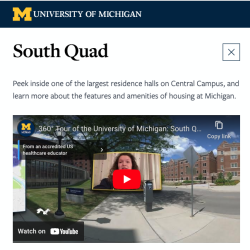
Another crucial aspect when working on video SEO for higher education is choosing the right hosting platforms. While YouTube is the most popular and SEO-friendly option, schools should consider other platforms where their target audience might be active, such as Vimeo, Facebook, TikTok, and Instagram. Additionally, embedding videos on the school’s website can improve engagement metrics like time-on-site, which are beneficial for SEO.
3. The Magic of Voice Search SEO and Long-Tail Keywords
Without a doubt, the phrases “Hey, Alexa!” and “Hey, Siri!” have become ingrained in our daily lexicon, signaling a shift in how we access information. This change has profound implications for SEO strategies, particularly in emphasizing the importance of voice search optimization. As more users turn to voice-activated assistants for their search queries, it becomes crucial for SEO strategies to adapt accordingly.
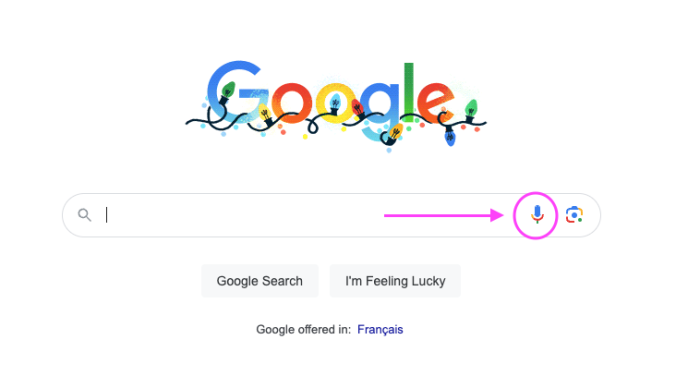
But what does this mean for higher education SEO? Optimizing for voice search requires focusing on natural language and question-based queries. Unlike traditional search methods, voice queries are longer, more conversational, and often take the form of direct questions. This shift calls for integrating long-tail keywords into higher education SEO strategies.
Incorporating conversational and long-tail keywords into your school’s content can make it easier for voice search algorithms to pick up and recommend their website. This means creating content that answers specific questions prospective students might ask, such as ‘What are the best business programs in London?’ or ‘How to become a personal support worker in Ontario?’ By optimizing for these conversational, question-based phrases, educational institutions can more effectively reach their audience through both voice search and traditional search methods, ensuring they remain at the forefront of this digital evolution.
4. Don’t Forget About Local SEO
Local SEO will be a key strategy in search engine marketing for higher education! This form of SEO is familiar, but it will be vital in helping schools attract students from their immediate geographical area. This form of search engine optimization involves various tactics, including optimizing the business’s Google My Business profile, getting listed in local directories, managing online reviews, and incorporating local keywords into their website content.
Example: Providing SERPs like Google with the correct information and posting regular updates can help schools like Algonquin Careers Academy effectively reach their target audience.
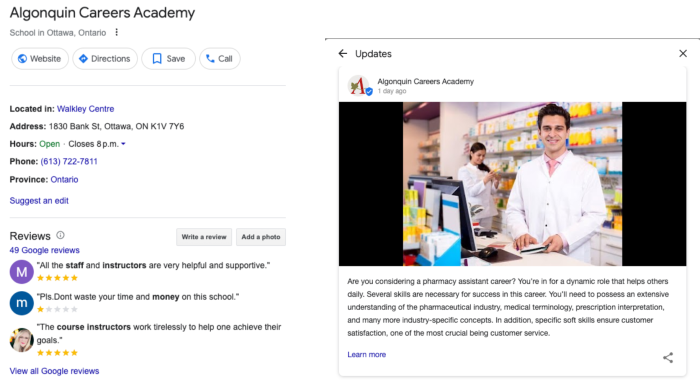
By focusing on Local SEO, schools can increase their visibility to a local audience and establish themselves as a prominent and accessible educational choice within their community.
5. We Said It Already, and We Say It Again: Long-Form Content Is Key
We discussed one of the most advanced SEO strategies for schools: long-form content. It was important to emphasize this strategy’s vital role. Long-form content addresses the specific queries and needs of prospective students and parents. This type of content helps rank for niche queries and establishes the school’s authority and expertise in various educational subjects and services.
Long-form content allows for an in-depth exploration of topics, so it can comprehensively answer your prospect’s queries. This thorough coverage tends to be valued by search engines, as it is seen as a more authoritative and informative resource. Additionally, longer content can lead to higher engagement, keeping visitors on the page longer. Metrics like time on page and bounce rate are indicators to search engines of the content’s value, potentially leading to higher rankings.
In 2025, long-form content will be essential in helping your school align with Google’s E-E-A-T principle, enhancing your online authority and expertise. Search engines, especially Google, prioritize content that demonstrates Experience, Expertise, Authoritativeness, and Trustworthiness. Long-form content provides the space to demonstrate expertise through detailed explanations, thorough research, and comprehensive knowledge of the subject matter. Highlighting faculty qualifications, accreditations, and student testimonials can significantly enhance a school’s authoritativeness online.
6. Page Speed, Mobile-Friendliness, and UX
In 2024, it was recorded that nearly 64% of all web traffic comes through mobile phones, and it is projected that by 2025, the number of mobile users worldwide will reach 7.49 billion. With this in mind, mobile-friendly websites are no longer an option but a must. If your school is not actively improving its mobile experience, this is one of the higher education SEO strategies you’ll want to implement this year. Schools that ensure the mobile experience of their students is optimal, as the University of British Columbia has done, are setting themselves up for success in today’s digital landscape. By optimizing their websites for mobile usability, schools can offer a seamless and engaging experience to students and parents. This includes easy navigation and a responsive design that adapts to various screen sizes.
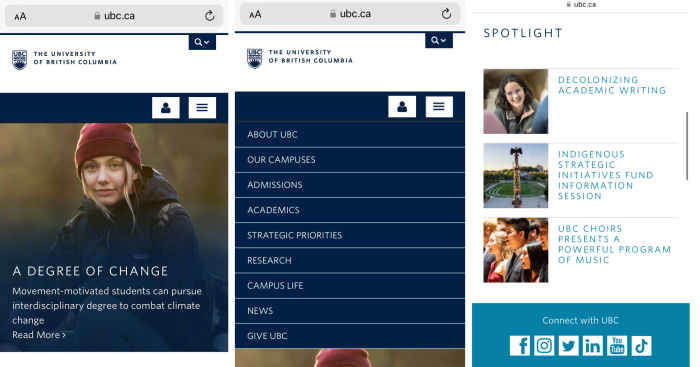
Source: University of British Columbia
Next in line are page speed and user experience (UX). A fast-loading website with an intuitive user interface is crucial for retaining visitors. The more your prospects wait for your website to load, the more likely they will leave. But speed optimization goes beyond user retention. Search engines like Google use page speed as a ranking factor. A faster website will keep your audience engaged and improve your search engine rankings, making your school more visible to prospective students.
A positive UX can lower bounce rates and increase the time users spend on your site, which are vital indicators of site quality used by search engines for ranking purposes. To improve UX, you can optimize images, leverage browser caching, and reduce server response time, among other technical strategies. We also recommend ensuring your school’s website design is visually appealing and aligns with your target audience’s expectations and preferences. For example, a site targeting high school students might incorporate more interactive elements, while a site focused on parents or adult learners might prioritize clarity and comprehensive information. Incorporating all these elements in your website design will ensure your visitors turn into qualified leads!







